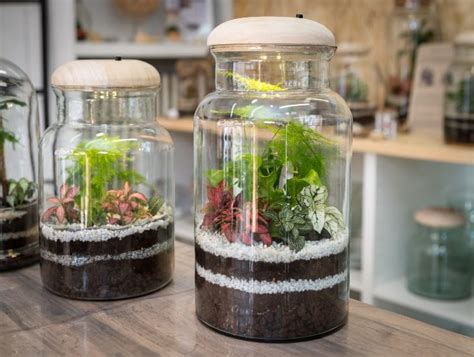Terrariums, miniature ecosystems encased in transparent containers, have gained immense popularity as a captivating form of home decor. Their aesthetic appeal and ability to bring a touch of nature indoors make them highly sought-after. However, the delicate nature of terrariums poses unique challenges when it comes to packaging and shipping. This comprehensive guide will delve into the intricacies of terrarium packaging and shipping, providing valuable insights and best practices to ensure the safe arrival of these fragile creations.

Understanding the Challenges of Terrarium Packaging and Shipping
Terrariums, by their very nature, are fragile and vulnerable to damage. The combination of live plants, soil, and glass or acrylic containers makes them susceptible to various hazards during transit. These include:
- Physical Impact: Rough handling, vibrations, and bumps can cause the glass or acrylic to crack or break, damaging the plants and ecosystem within.
- Temperature Fluctuations: Extreme temperatures can harm the plants, especially those that require specific temperature ranges.
- Moisture Control: Excessive moisture can lead to mold growth and damage to the plants. Conversely, insufficient moisture can cause plants to wilt and die.
- Light Exposure: Plants need adequate light for photosynthesis, but excessive light can cause them to burn or overheat.
Step-by-Step Guide to Terrarium Packaging and Shipping
To mitigate these challenges and ensure successful shipping, it is essential to follow a meticulous packaging and shipping process. Here is a detailed guide to help you achieve this:
1. Prepare the Terrarium for Shipping
- Securely Close the Container: Ensure the terrarium container is tightly sealed to prevent any leakage or damage during transit.
- Wrap Plants Individually: If possible, wrap individual plants or small clusters of plants in tissue paper or bubble wrap for added protection.
- Add Cushioning Material: Fill empty spaces within the terrarium with soft, non-abrasive materials such as bubble wrap, packing peanuts, or shredded paper. This will cushion the plants and prevent movement within the container.
2. Package the Terrarium in a Shipping Box
- Choose the Right Box Size: Select a shipping box that is slightly larger than the terrarium, allowing for ample cushioning material around it.
- Use a Sturdy Box: Opt for a box made of durable cardboard or plastic to withstand the rigors of shipping.
- Pad the Box with Cushioning Material: Line the bottom of the box with a generous layer of cushioning material.
3. Secure the Terrarium in the Box
- Center the Terrarium: Place the terrarium in the center of the box and ensure it is securely positioned.
- Fill Void Spaces with Cushioning: Fill any remaining void spaces around the terrarium with additional cushioning material.
- Seal the Box Tightly: Close the shipping box securely using packing tape, ensuring a snug fit to prevent movement during transit.
4. Label and Ship the Package
- Label Clearly: Affix clear and visible shipping labels with the recipient’s address, return address, and any necessary handling instructions.
- Mark as Fragile: Clearly mark the package as “Fragile” to alert handlers to its delicate nature.
- Choose a Reliable Shipping Carrier: Select a reputable shipping carrier that offers appropriate handling and tracking options for fragile items.
Tips and Tricks for Enhanced Terrarium Protection
Beyond the basic packaging and shipping procedures, consider these additional tips to further enhance the protection of your terrariums during transit:
- Use Self-Watering Terrariums: Opt for self-watering terrariums that require less maintenance during transit, reducing the risk of moisture-related issues.
- Include Detailed Instructions: Provide clear instructions for the recipient on how to unpack and care for the terrarium to minimize the potential for mishandling.
- Consider Insurance: Purchasing shipping insurance can provide peace of mind and protect your investment in case of damage or loss.
Shipping Costs and Considerations
The cost of shipping terrariums can vary depending on several factors:
- Size and Weight: Larger and heavier terrariums will incur higher shipping costs.
- Distance: Shipping across longer distances typically results in increased costs.
- Shipping Speed: Expedited shipping options will be more expensive than standard delivery.
- Carrier Selection: Different shipping carriers have varying pricing structures and service offerings.
Emerging Trends and Innovations
As terrarium popularity continues to grow, new trends and innovations are emerging to improve packaging and shipping practices. These include:
- Biodegradable Packaging: Sustainable packaging materials, such as cornstarch-based peanuts and mushroom-based cushioning, are gaining traction as alternatives to traditional plastics and foams.
- Smart Packaging: Advanced packaging solutions that monitor temperature and humidity during transit can help ensure optimal conditions for terrariums.
- Drones for Delivery: Drone delivery services offer the potential for faster and more efficient delivery of fragile items like terrariums, reducing handling risks.
Conclusion
Terrarium packaging and shipping require careful planning and attention to detail to ensure the safe arrival of these delicate ecosystems. By following the comprehensive guide outlined in this article, you can effectively protect your terrariums and provide peace of mind throughout the shipping process. As the terrarium industry continues to evolve, stay up-to-date on emerging trends and innovations to optimize your shipping strategies and enhance customer satisfaction.





















